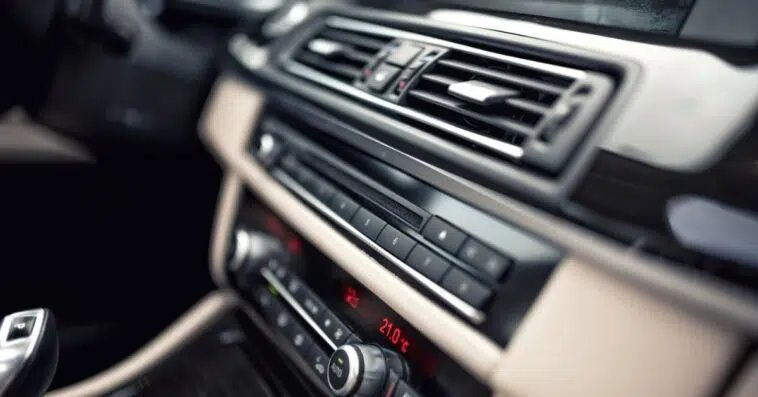ACs are installed in the car to comfort you when you are on the roads, stressed and irritated by traffic.
For providing the users a cool and refreshing air every time they use the AC, the AC systems use a key component called refrigerant or Freon.
As you use your car AC, the refrigerant reduces. So now, as it decreases, you need to refill the refrigerant for your AC to continue to serve you with the refreshing and cold air.
Furthermore, having a low Freon level can result in overheating issues, and your AC will not be working as it should.
So, if you are wondering how to check Freon level in car, then you are in the right place. Checking the Freon level is not at all complicated as it sounds.
The process I am about to share is one of the easiest ways to check the Freon level in your car and determine if there is a need to get your vehicle recharged.
Also, there is no need to pay for a visit to a professional.
Here is how; you can use a gauge. If the indicator reads anything between 25 psi to 45 psi, it means you have a sufficient amount of Freon in your car.
I will use a gauge, so I want you to follow the steps and do what is directed. It is pretty straightforward.
But before we jump off the main topic, it is necessary to know precisely fFeon and how it works.
TABLE OF CONTENTS
What Is Freon, And How Does It Work?
Freon is a trademark registered explicitly for a particular product that serves as a refrigerant for air conditioning units in automobiles.
This refrigerant is a mixture of chlorine, carbon-hydrogen, and fluorine.
This substance is like gas when at room temperature but immediately transforms into a liquid state when compressed or the temperature gets cold.
Most of the Freon available in the market are odorless, have no colors, and are non-flammable. However, these substances can prove to be very toxic if they come in contact with your eyes or skin.
The Freon is a refrigerant that can convert from a gaseous state to a liquid state and over again to a gaseous state.
The air conditioning system makes this conversion cycle, and when this cycle ends, the Freon takes a refreshing and cold form of gas in the evaporator.
Now, the Freon in the evaporator, a fan brings air from the outside, and the Freon cools it down due to its cold temperature. Then the air is sent as a cool and refreshing air into the car through the vents.
Now, let us look at the procedures involved in checking your car’s Freon level.
Procedure To Check Freon Level In Your Car
Before we begin, you need to get a hold of a thermometer, gloves, safety goggles, and an AC gauge. You can quickly get them in any car-part shop.
Let’s get started with the steps:
1. Quick Inspection
Before you touch anything of your car, I want you to put on your safety goggles.
With the safety goggles on, take a quick scan of the air conditioning unit, looks for loose clamps and leakage if there are any.
If you find any loose clamps, replacing them with new ones will save you some money. However, if you get to see leaks, contacting your professional mechanic shall be the best option.
If you do not see any leakage, you are all set for the next step.
2. Connect Service Ports With The Gauges
There are mainly two service ports you get to see in the car, a port with lower pressure and higher pressure.
These ports are located in different places. Read on, and I made it easier for you to find them.
The low-pressure port can be seen between the compressor and the accumulator (on the passenger side of your car’s firewall).
At the same time, the high-pressure port is caught between the evaporator and the condenser (located right in front of the radiator).
If you have difficulty finding them, you can get a piece of detail information about their location in your car’s manual. After you find them, you need to attach the gauges to the respective ports.
3. Set The Highest Level Of Your AC (Max)
Start your car and then set the air conditioning system to its highest level or maximum level.
There are some differences in the AC controllers, and different cars have different configurations. Now, if you have a recirculation option, apply the recirculation of air.
After setting the AC to its max level, you have to put the thermometer near the AC vent located on the Dash.
If you get a reading of 40 degrees Fahrenheit, this indicates your system is functioning normally.
4. Let The Compressor Cycle For A Few Minutes
After you are done attaching the gauges and setting the AC, you need to allow your compressor to stabilize and cycle the pressure, and then you will be able to bet the measurement of the Freon or refrigerant.
When taking measurements, it is essential to note that the low-pressure port will read between 25 psi to 45 psi in the usual case.
And when taking the measures of the high-pressure port, the gauge will give you a reading between 250 psi to 400 psi.
Say you get a comparatively lower reading on both lower and high-pressure ports, and it means you are running low on Freon level.
Warning
Use products recommended for the Air Conditioning units. Never work on pressurized systems with bare eyes; always wear safety goggles. And never try to attach the gauges when the engine is on.
Car Ac Systems Require High Maintenance
If you cannot manage time to check your car’s other components, it’s okay, but there should be no compromises with the air conditioning systems.
This system plays a crucial role and affects your car’s performance.
Even a quick visual scan can help in identifying leaks. You should look closely at the seals because these get loose over time and falls, which in turn causes leakage of the Freon.
A quick servicing and checking session can help exterminate contaminants from the air conditioning unit, and you need to repeat them every three years.
Also, it would be best if you considered replacing other components like the tubes to help get rid of potentially damaging particles and ensure enhanced performance.
The air cabins get dirty with use which puts a lot of pressure on your AC system, and it gets harder for your AC to work efficiently.
If you wish, you can replace the cabin after every 10,000 miles and enhance the airflow.
4 Symptoms Of Low Freon Level
If you observe your AC giving out a bit of warm air, it may determine that you are running low on Freon.
Also, some symptoms can help you determine a low Freon level and need to be recharged.
- Reduced Cooling: If you feel your AC is not functioning or not cooling correctly, it may be because of the low Freon level.
- Sound Of Clutch Engaging: The moment to turn on your car AC, you can hear the sound of the AC clutch engaging. The AC switch engages this clutch that reads the pressure level of the AC system. The clutch is primarily installed to read refrigerant levels. Therefore, when you have low Freon, neither will activate the pressure nor the clutch will engage. If the clutch does not engage, the system will be unable to circulate the air.
- Icy Compressor: If you notice an icy compressor or a bit of ice on your compressor, it is a vital sign that indicates a lower Freon level. When your car runs out of Freon, the AC lines are just left with water. If there is no Freon or refrigerant, the water will start to freeze.
- Refrigerant Leaks: Encountering refrigerant leaks is a very distinctive sign and is a significant indication for you to recharge your car with Freon.
If you get to see leaks in your car, it would be best to get it fixed without any delay. If you do not fix it, your vehicle will always run out of Freon.
Why Does My Car AC Need A Freon Recharge?
If you have an air conditioning unit at home, you know that there is a need for recharging or servicing it annually. The same goes for your car AC as well.
If your car air conditioning unit is not serving you with refreshing and cold air, then you have to consider recharging your AC.
Therefore, recharging your car AC is essential for the air conditioning system and also for the vehicle. If your AC does not work the way, it should maybe need a recharge.
Even if you consider recharging your Air Conditioning unit, try not to fill it with excessive refrigerant, which can impose a pretty significant issue for your car.
Also, if you do not recharge it with sufficient refrigerant, it can affect your car’s performance. Hence, recharge your AC with an adequate amount of refrigerant.
Which Refrigerant Shall Be The Best For My Vehicle?
There are three types of Freon variants that automotive companies use.
- First is the R12 refrigerant, the oldest, cheap, and pretty efficient refrigerant. Hugely used in the ’90s and was used by classic cars.
- The second is the R134a. Chances are, this refrigerant is probably there in your car at this very moment. This is the most common refrigerant that was used since 1994. The R134a contains a tremendous amount of CFC-12 and HFC-23, and other greenhouse gases. However, due to its harmful nature, industries no longer use this refrigerant.
- The third is the R1234yf, a newly introduced refrigerant that replaces the harmful R134a refrigerant. The majority of the counties use this variant of refrigerant for the vehicles. Therefore, it can be the best one you should use.
Frequently Asked Questions
Q1. How Long Will The Freon Last In My Vehicle?
An air conditioning unit is not something that needs to work for hours. You only turn it on only when it is necessary.
Also, it depends on some factors like generally, the Freon or refrigerant can last up to three years approximately.
However, if you live in a cold temperature, there is no need to recharge your Freon that frequently. Because when you live in a place with colder temperatures, you do not need the AC often.
Also, if you have some issues like leaking of the refrigerant or other AC issues, then the Freon will be consumed pretty fast. This will make you recharge your Freon very often.
Q2. What Makes My Air Conditioning System Leak?
If you want to know what makes your ac system leak, it depends on the age of your ac system, and it will leak when it is exposed to moisture.
Rubber clamps can lose their grip over time and fall off, giving the Freon a chance to flow out and moisture to enter your system.
If the moisture gets mixed with the Freon, it can develop into an acid that can cause corrosion in the entire system and harm the accumulator, receiver, and drier.
Q3. Is It Safe To Check My Car’s Freon Level On My Own?
Yes, you can check your car’s Freon level all by yourself. All you need is some tools and safety measures. Then, with a bit of tech knowledge and idea, you can do it all.
But, be cautious about touching the engine while it is hot and still works. Shut your engine wait for it cool down, and then begin. Always wear gloves, wear safety glasses and maintain a safe distance.
Conclusion
Voila, now that you have read this article, it is not unusual to expect that this article helped you. The fact is every vehicle needs a Freon recharge.
So measuring the Freon level not only helps you maintain your car but can also save you more extraordinary expenses if your AC unit gets damaged.
Here in this article, I have mentioned the easy steps regarding how to check Freon level in car that you can use to check your car’s Freon level.
Moreover, I have stated some of the symptoms that can help you determine the Freon level is significantly low in your vehicle.
Ac blowing warm air is a sign of low Freon levels, so you need to figure out the prime reason behind these AC issues. There can be many possibilities.




